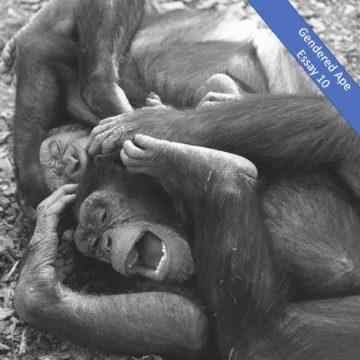Editor’s Note: Frans de Waal’s new book, Different: Gender Through the Eyes of a Primatologist, has generated some controversy and misunderstanding. He will address these issues in a series of short essays which will be published at 3QD and can all be seen in one place here. More comments on these essays can also be seen at Frans de Waal’s Facebook page.
by Frans de Waal

No one can deny the traditional (and ongoing) gender inequality in human society, which disadvantages girls and women. It’s a huge injustice that we need to fight.
But who says that elimination of gender differences is the solution? Or that we need to promote gender-neutrality?
Of the two words in “gender inequality,” only one is a problem, and it isn’t “gender.”
A fully gender-neutral upbringing of children may not even be feasible. Human biology isn’t blind to sex. The breastmilk of mothers, for example, varies dependent on whether she’s nursing a boy or a girl. Milk for male babies has a greater energy content. Milk of monkey mothers shows the same difference.
Young male primates are more energetic and rambunctious than same-aged females. When hundreds of children in different nations were outfitted with accelerometers to measure body movements, boys showed far more bursts of vigorous locomotion than girls. That boys are also three times more likely than girls to be diagnosed with attention-deficit/hyperactivity disorder (ADHD) reflects the same difference.
The higher energy level of young males is a universal sex difference. But there are others. There is for example the greater interest in babies and dolls by immature female primates (see Essay #1 of this series), and the penchant of young males to test their strength on each other. Known as rough-and-tumble play, wrestling games are the favorite pastime of young male primates. In our species, too, these games typify boys more than girls.
Keep in mind, however, that sex differences are always statistically bimodal with intersecting distributions: the famous overlapping bell curves.
There aren’t as many developmental studies of primates as I’d like, but primatologist Elizabeth Lonsdorf observed how young male chimpanzees travel independently of their mothers at an earlier age than young females. They are found at greater distances from her even though they remain dependent for ten years.
Similarly, anthropologist Carolyn Edwards documented child development in ten human cultures in the 1950s — before Western television overtook the world — in countries as diverse as Kenya, Mexico, the Philippines, and India. She found girls to be more involved in infant care and boys to have more freedom to roam. Everywhere, boys played away from home more than girls.
Cross-species similarities don’t mean that styles of upbringing are fixed or that we shouldn’t try to equalize them between the genders. We have great flexibility. But it may be an illusion to think that development is entirely in the parents’ hands. The young socialize themselves by the experiences they seek and the models they emulate. After a certain age, peers also begin to influence them. Parents may have less control than they like to think.
Inevitably, gender thrusts itself into the spotlight when the young reach puberty. They develop sexual interests, and for most individuals – whether they’re raised gender-neutral or not — those interests will be biased towards a particular gender.
Those who think that gender-neutrality will pave the way for gender equality should consider that no moral law states that equality requires similarity.
***
FURTHER READING
Essay #1: Is the Maternal Instinct a Myth?
Katie Hinde (2007). First-time macaque mothers bias milk composition in favor of sons. Current Biology 17: R958–R959.
Elizabeth Lonsdorf (2017). Sex differences in nonhuman primate behavioral development. Journal of Neuroscience Research 95: 213–221.
For further details and references to the literature, read “Different: Gender Through the Eyes of a Primatologist” (Norton, 2022). A video about the book can be seen here: https://fb.watch/ffbauZBzNb/
